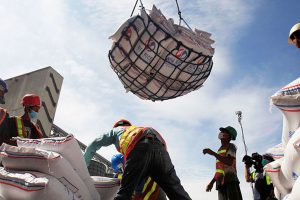By Luisa Maria Jacinta C. Jocson, Reporter
THE government’s proposal to prolong a low-tariff regime for key agricultural commodities runs the risk of discouraging farmers from growing produce that competes with the imports, farmers’ organizations said.
“It appears that the tariff reductions have not been able to significantly and proportionately reduce retail prices. This means that it is the importers and traders who are benefitting from the reduction, at the expense of producers, and with no sizable benefit to consumers,” Raul Q. Montemayor, chairman of the Federation of Free Farmers, said in a Viber message.
“Any measure that adversely affects our farmers will discourage them from continuing to farm; when this happens, the long-term price stability of our agricultural products will be compromised,” Asis G. Perez, co-convenor of food advocacy group Tugon Kabuhayan, said in a text message.
Last week, Finance Secretary Benjamin E. Diokno said the government is considering extending the validity period for reduced Most Favored Nation tariff rates on pork, corn, rice and coal.
Executive Order (EO) No. 10, which was signed in December, extended the lower tariff rates for imports of swine meat (15% for shipments within the minimum access volume (MAV) quota and 25% for those exceeding the quota), corn (5% for MAV imports and 15% for those beyond the quota), and rice (35% for both MAV and non-MAV shipments.) These rates will be in effect until Dec. 31.
It also kept coal import duties at zero beyond Dec. 31. Rates are subject to review every half year after that date.
“We would have thought that our economic team would finally have the courage to accept the fact that they failed miserably in equating unlimited imports and lowering tariffs on meat, rice and corn as our primal solution to fighting inflation,” Samahang Industriya ng Agrikultura (SINAG) Executive Director Jayson H. Cainglet said in a statement.
“Three years since the first EO was signed by then-President Duterte that lowered the tariffs on rice, meat and corn; the reverse has actually happened,” he added, referring to still-high prices.
SINAG said domestically-grown well-milled rice had commanded P34-39 per kilogram prior to the EO.
Department of Agriculture (DA) price monitors currently put well-milled rice prices at P42-52 per kilo.
“Lowering tariffs has only benefitted and incentivized a few privileged importers and favored traders,” Mr. Cainglet said.
DA price monitors also reported pork shoulder (kasim) selling for up to P330 per kilo and pork belly (liempo) at up to P390 per kilo.
Mr. Montemayor said that the tariff reduction has also not succeeded in diversifying foreign suppliers of farm imports.
“In the case of rice, more than 85% of our imports came from ASEAN countries during the first six months of 2023, debunking the claims of the economic managers that reducing tariffs on non-ASEAN rice would significantly diversify our sources of rice,” he said.
In the seven months to July, the Philippines imported 1.96 million metric tons (MT) of rice, according to the Bureau of Plant Industry.
Vietnam was the top supplier of imported rice during the period, accounting for 89.68% of the total. Much of the rest was from Myanmar and Thailand.
Mr. Cainglet said that imports have become less feasible as a means of keeping up a buffer stock in case of extreme weather events because exporting countries are keeping a lid on rice being shipped overseas.
“Countries with surplus production have been limiting their allocation for exports as a way of increasing their local stocks. Nations across the globe are all protecting their local agriculture and building capacity for self-reliance,” he added.
Meanwhile, former Agriculture Undersecretary Fermin D. Adriano said that the tariff cut extension may be necessary if the supply situation tightens.
“If the country is experiencing a shortage of a commodity, leading to higher prices, then there is justification for extending lower tariffs,” he said in a Viber message.
The DA has recently called on the private sector to import over a million metric tons of rice amid supply concerns. The DA also announced that it is preparing to import 1.3 million MT of rice.
The rice supply is projected to hit 5.47 million MT in the third quarter, with demand seen at 3.79 million MT. This would bring inventory at the end of the quarter to 1.69 million MT, equivalent to 45 days’ demand.
Mr. Montemayor said that the government should focus on supporting farmers instead of relying on imports.
“Given recent developments in the international marketplace, the government strategy should be to encourage domestic production and avoid unnecessary and large tariff cuts which will only discourage producers from expanding their ouput, consequently making us even more reliant on imports,” he said.
“Our view is for the government to see the long-term implications of their actions, as opposed to looking for short-term solutions that will permanently damage the viability of our agriculture industry,” Mr. Perez added.
Support from the private sector will also be crucial to boost productivity, Mr. Cainglet said.
“The last two cropping seasons have been very positive to our rice farmers because of the extended help of the private sector and the increased fuel and fertilizer subsidies from the government. Farmgate prices have increased and the cost of producing palay (unmilled rice) has been reduced because of these interventions,” he added.
“These developments are encouraging farmers to plant and more institutional support from the DA would further encourage the local rice industry,” he added.
Mr. Cainglet called on the government to “support our producers and incentivize industry users of food as well as agri-entrepreneurs, promote food sovereignty and do away with the mentality that imports are manna from benevolent importers.”

